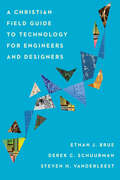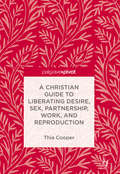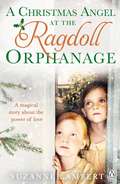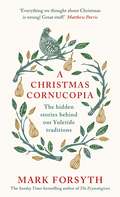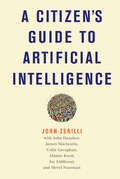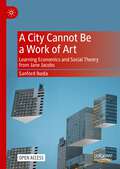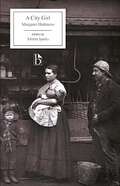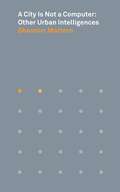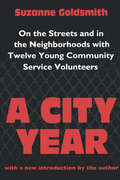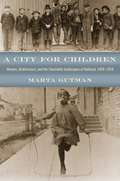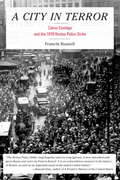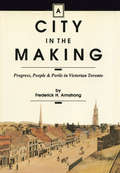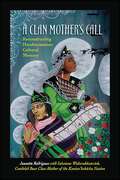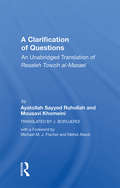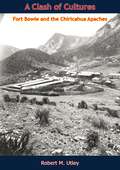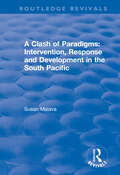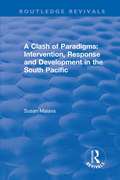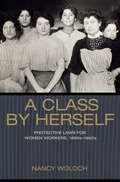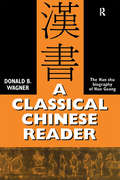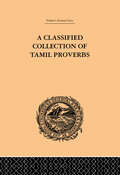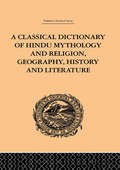- Table View
- List View
A Chosen Exile: A History of Racial Passing in American Life
by Allyson HobbsCountless African Americans have passed as white, leaving behind families and friends, roots and communities. It was, as Allyson Hobbs writes, a chosen exile. This history of passing explores the possibilities, challenges, and losses that racial indeterminacy presented to men and women living in a country obsessed with racial distinctions.
A Christian Field Guide to Technology for Engineers and Designers
by Derek C. Schuurman Ethan J. Brue Steven H. VanderLeestOur technology shapes the way we live, interact, work, play, and even worship.biblical themes and passages that relate to technologythe ethics and norms involved in technology designhow engineering and technology tap into human dreams for a better worldAlong the way they acknowledge the challenges arising from technology but also point to the wonderful possibilities it offers us and its ability to contribute to the common good. For Christians studying and working in engineering, computer science, technical design, architecture, and related fields, this book is packed with wisdom and practical guidance. By sharing what they have learned, the authors encourage readers to ask harder questions, aspire to more noble purposes, and live a life consistent with their faith as they engage with technology.
A Christian Guide to Liberating Desire, Sex, Partnership, Work, and Reproduction
by Thia CooperWhat is good sex from the perspective of liberation theology? Thia Cooper argues that sex can be a way to know God. God created humans with a desire to be in relation with each other. From this understanding, sexual desire, sex, and partnerships are re-imagined positively. Good sex is enjoyable and mutual, an aspect of communion. Good sexual relationships share power, empower the participants, and the wider community. From the perspective of liberation theologies and an analysis of biblical texts, the Christian tradition, and the reality of our sexual experience, this book reframes theologies of partnership, sex work, and reproduction through the celebration of desire and sex.
A Christmas Angel at the Ragdoll Orphanage
by Suzanne LambertAn unforgettable true story . . . A heartwarming tale about the true meaning of Christmas, set in a remarkable orphanage in the middle of the last century. When Suzanne was left, two weeks old, at the door of an orphanage, it was Nancy the nanny who fought for the right to adopt Suzanne. Now, 60 years later, Suzanne is sharing the untold story of all the many orphans that her mother Nancy saved throughout the 1940s and 50s. As a teenager, Nancy accompanied the orphans to the other side of the country when they were evacuated during the war years. When they finally returned, 6 long years later, she vowed to dedicate her life to the children. A Christmas Angel at the Ragdoll Orphanage tells the story of a remarkable woman, who worked tirelessly to give society's most vulnerable children a chance of home and happiness. Full of touching, tear-jerking and unforgettable stories, this is a wondrously festive book all about the real meaning of motherhood.
A Christmas Cornucopia: The Hidden Stories Behind Our Yuletide Traditions
by Mark ForsythBY THE SUNDAY TIMES NO.1 BESTSELLING AUTHOR OF A SHORT HISTORY OF DRUNKENNESSDiscover the unpredictable origins and etymologies of our Christmas customs this festive season. For something that happens every year of our lives, we really don't know much about Christmas. We don't know that the date we celebrate was chosen by a madman, or that Christmas, etymologically speaking, means "Go away, Christ". We're oblivious to the fact that the advent calendar was actually invented by a Munich housewife to stop her children pestering her for a Christmas countdown. And we would never have guessed that the invention of crackers was merely a way of popularising sweet wrappers. Luckily, like a gift from Santa himself, Mark Forsyth is here to unwrap this fundamentally funny gallimaufry of traditions and oddities, making it all finally make sense - in his wonderfully entertaining wordy way.'Witty and revelatory. Blooming brilliant' Raymond Briggs 'Everything we ever thought about Christmas is wrong! Great stuff' Matthew Parris
A Citizen's Guide to Artificial Intelligence
by John ZerilliA concise but informative overview of AI ethics and policy.Artificial intelligence, or AI for short, has generated a staggering amount of hype in the past several years. Is it the game-changer it's been cracked up to be? If so, how is it changing the game? How is it likely to affect us as customers, tenants, aspiring home-owners, students, educators, patients, clients, prison inmates, members of ethnic and sexual minorities, voters in liberal democracies? This book offers a concise overview of moral, political, legal and economic implications of AI. It covers the basics of AI's latest permutation, machine learning, and considers issues including transparency, bias, liability, privacy, and regulation.
A City Cannot Be a Work of Art: Learning Economics and Social Theory From Jane Jacobs
by Sanford IkedaThis open access book connects Jane Jacobs's celebrated urban analysis to her ideas on economics and social theory. While Jacobs is a legend in the field of urbanism and famous for challenging and profoundly influencing urban planning and design, her theoretical contributions – although central to her criticisms of and proposals for public policy – are frequently overlooked even by her most enthusiastic admirers. This book argues that Jacobs’s insight that “a city cannot be a work of art” underlies both her ideas on planning and her understanding of economic development and social cooperation. It shows how the theory of the market process and Jacobs’s theory of urban processes are useful complements – an example of what economists and urbanists can learn from each other. This Jacobs-cum-market-process perspective offers new theoretical, historical, and policy analyses of cities, more realistic and coherent than standard accounts by either economists or urbanists.
A City Girl: A Realistic Story
by Margaret HarknessIn April 1888, Friedrich Engels wrote a letter to the English novelist and journalist Margaret Harkness, expressing his appreciation for her first novel, A City Girl: A Realistic Story, calling it “a small work of art.” A City Girl was one of many slum novels set in the East End of London in the 1880s. It tells the story of a young East Ender, Nelly Ambrose, who is seduced and abandoned by a middle-class bureaucrat. After the birth of her child and betrayal by her family, Nelly is rescued by two outside forces: the Salvation Army and a sympathetic local man, George, who wants to marry her despite her “fallen” status. While Nelly’s relative passivity and social ignorance distinguish her from contemporary New Woman heroines, Harkness’s sympathy for Nelly’s position and refusal to judge her morally make A City Girl a fascinating and original novel.
A City Is Not a Computer: Other Urban Intelligences (Places Books #2)
by Shannon MatternA bold reassessment of "smart cities" that reveals what is lost when we conceive of our urban spaces as computersComputational models of urbanism—smart cities that use data-driven planning and algorithmic administration—promise to deliver new urban efficiencies and conveniences. Yet these models limit our understanding of what we can know about a city. A City Is Not a Computer reveals how cities encompass myriad forms of local and indigenous intelligences and knowledge institutions, arguing that these resources are a vital supplement and corrective to increasingly prevalent algorithmic models.Shannon Mattern begins by examining the ethical and ontological implications of urban technologies and computational models, discussing how they shape and in many cases profoundly limit our engagement with cities. She looks at the methods and underlying assumptions of data-driven urbanism, and demonstrates how the "city-as-computer" metaphor, which undergirds much of today's urban policy and design, reduces place-based knowledge to information processing. Mattern then imagines how we might sustain institutions and infrastructures that constitute more diverse, open, inclusive urban forms. She shows how the public library functions as a steward of urban intelligence, and describes the scales of upkeep needed to sustain a city's many moving parts, from spinning hard drives to bridge repairs.Incorporating insights from urban studies, data science, and media and information studies, A City Is Not a Computer offers a visionary new approach to urban planning and design.
A City Year: On the Streets and in the Neighbourhoods with Twelve Young Community Volunteers
by Suzanne GoldsmithIn his inaugural address in 1993, President Clinton said: "I challenge a new generation of young Americans to a season of service to act on your idealism by helping troubled children, keeping company with those in need, reconnecting our torn communities." In the fall of 1990, Suzanne Goldsmith had signed on for her own "season of service" with City Year, the widely praised, Boston-based community service program frequently endorsed by political figures as a model for the nation. 'A City Year' is the story of Goldsmith's experience, an honest and gritty account of the triumphs and setbacks faced by an idealistic and experimental social program in its infancy. Together with a diverse team of young men and women--including a Burmese immigrant, a white prep-school graduate, a foster child, an ex-convict, and a black middle-class college student--Goldsmith helped renovate a building for the homeless, tutored school children, reclaimed a community garden from drug dealers, and organized a community street-cleaning day. The year Included backbreaking but gratifying work, the sense of family that comes from collaborative labor, and the potential strength of diversity. 'A City Year' is both the story of an uphill battle in urban America and an uplifting recipe for social change. As the AmeriCorps national service program dangles in the political wind on Capitol Hill, this book offers a true glimpse of what a "season of service" really means. It is a fascinating account for sociologists and all those with an interest in community service and youth.
A City by City Guide to Living and Working in Australia
by Roberta DumanMigration to Australia is not always straightforward, nor is it the right choice for everyone. This book is designed to assist people in making an informed decision ahead of taking the huge step to relocate. It will equip readers with enough information to prepare them for the day-to-day realities of living and working in Australia, as this often turns out to be very different from what was expected. Part One is a general overview to Living in Australia and details the complex visa process, finance, healthcare, lifestyle, property and education. It also contains up to date information on the current economic situation, which industries are on the rise and decline, how to go about your job search from the UK and Australia, where to look for work and how to increase your opportunities and secure the correct visa. Part Two examines Australia's main cities (Sydney, Melbourne, Brisbane, Perth, Adelaide, Canberra and Tasmania) and provides comprehensive information about what to expect from each in terms of lifestyle, employment opportunities, recreation, residential options and information on education and childcare for those with families. Written from personal experience, this book seeks to reduce some of the stress involved in making the momentous decision to live / work in Australia and offers valuable advice and tips on how to save time and money.
A City by City Guide to Living and Working in Australia
by Roberta DumanMigration to Australia is not always straightforward, nor is it the right choice for everyone. This book is designed to assist people in making an informed decision ahead of taking the huge step to relocate. It will equip readers with enough information to prepare them for the day-to-day realities of living and working in Australia, as this often turns out to be very different from what was expected. Part One is a general overview to Living in Australia and details the complex visa process, finance, healthcare, lifestyle, property and education. It also contains up to date information on the current economic situation, which industries are on the rise and decline, how to go about your job search from the UK and Australia, where to look for work and how to increase your opportunities and secure the correct visa. Part Two examines Australia's main cities (Sydney, Melbourne, Brisbane, Perth, Adelaide, Canberra and Tasmania) and provides comprehensive information about what to expect from each in terms of lifestyle, employment opportunities, recreation, residential options and information on education and childcare for those with families. Written from personal experience, this book seeks to reduce some of the stress involved in making the momentous decision to live / work in Australia and offers valuable advice and tips on how to save time and money.
A City for Children: Women, Architecture, and the Charitable Landscapes of Oakland, 1850-1950
by Marta GutmanAmerican cities are constantly being built and rebuilt, resulting in ever-changing skylines and neighborhoods. While the dynamic urban landscapes of New York, Boston, and Chicago have been widely studied, there is much to be gleaned from west coast cities, especially in California, where the migration boom at the end of the nineteenth century permanently changed the urban fabric of these newly diverse, plural metropolises. Ina"A City for Children," Marta Gutman focuses on the use and adaptive reuse of everyday buildings in Oakland, California, to make the city a better place for children. She introduces us to the women who were determined to mitigate the burdens placed on working-class families by an indifferent industrial capitalist economy. Often without the financial means to build from scratch, women did not tend to conceive of urban land as a blank slate to be wiped clean for development. Instead, Gutman shows how, over and over, women turned private houses in Oakland into orphanages, kindergartens, settlement houses, and day care centers, and in the process built the charitable landscapeOCoa network of places that was critical for the betterment of children, families, and public life. a The industrial landscape of Oakland, riddled with the effects of social inequalities and racial prejudices, is not a neutral backdrop in GutmanOCOs story but an active player. Spanning one hundred years of history, a"A City for Childrena"provides a compelling model for building urban institutions and demonstrates that children, women, charity, and incremental construction, renovations, alterations, additions, and repurposed structures are central to the understanding of modern cities. "
A City in Terror: Calvin Coolidge and the 1919 Boston Police Strike
by Francis RussellOn September 9, 1919, an American nightmare came true. The entire Boston police force deserted their posts, leaving the city virtually defenseless. Women were raped on street corners, stores were looted, and pedestrians were beaten and robbed while crowds not only looked on but cheered. The police strike and the mayhem that followed made an inconspicuous governor, Calvin Coolidge, known throughout America, turning him into a national hero and, eventually, a president. It also created a monster: for two days, more than 700,000 residents of Boston's urban core were without police protection, and the mob ruled the streets.
A City in the Making: Progress, People and Perils in Victorian Toronto
by Frederick H. ArmstrongA City in the Making examines certian of the events that took place in the nineteenth century Toronto, paying particular attention to those who carved a thriving metropolis out of the frontier post that was the town of York.
A Clan Mother's Call: Reconstructing Haudenosaunee Cultural Memory (SUNY series in Critical Haudenosaunee Studies)
by Jeanette RodriguezIndigenous communities around the world are gathering to both reclaim and share their ancestral wisdom. Aware of and drawing from these social movements, A Clan Mother's Call articulates Haudenosaunee women's worldview that honors women, clanship, and the earth. Over successive generations, First Nation people around the globe have experienced and survived trauma and colonization. Extensive literature documents these assaults, but few record their resilience. This book fulfills an urgent and unmet need for First Nation women to share their historical and cultural memory as a people. It is a need invoked and proclaimed by Clan Mother, Iakoiane Wakerahkats:teh, of the Mohawk Nation. Utilizing ethnographic methods of participatory observation, interviewing and recording oral history, the book is an important and useful resource for capturing "living" histories. It strengthens the cultural bridge and understanding of the Haudenosaunee people within the United States and Canada.
A Clarification Of Questions: An Unabridged Translation Of Resaleh Towzih Al-masael
by Ruhollah (ayatollah) KhomeiniThis unabridged translation of Ayatollah Khomeini's A Clarification of Questions provides a unique picture of the belief structure of Shi'ism. A compendium of 3000 "problems," Khomeini's treatise is intended to guide laymen in their religious duties, as well as to cover all of life's questions and needs, from personal hygiene and ritu
A Clash of Cultures: Fort Bowie and the Chiricahua Apaches
by Robert M. UtleyRelates the history of the Apache Indians and of the Apache Wars of the 1800's. The Apache Wars ended with the surrender of their leader Geronimo. The parts played by Apaches Geronimo and Cochise, United States Army officers, Oliver Otis Howard, George Crook, and Nelson A. Miles, and many others are given in the narrative. Today the ruins of Fort Bowie, Arizona, stand as a monument commemorating the struggle of the Indians to maintain their way of life in the face of the white man's determination to conquer the wilderness.
A Clash of Paradigms: Response and Development in the South Pacific (Routledge Revivals)
by Suan MaiavaThis title was first published in 2001. This study indicates that researchers have far to go in understanding and assessing how development projects work. The author shows that, often, the perception of failure is not shared by those whom were intended to benefit. She uses a case study of Samoan villagers introduced to cattle farming to examine the wider development process and challenge the conventional theories. By drawing on people-centred perspectives that give much greater weight to the role of culture in development, the volume does not simply criticize development project management, but suggests practical and positive ways forward, encouraging spontaneous indigenous development which should be supported by projects where appropriate.
A Clash of Paradigms: Response and Development in the South Pacific (Routledge Revivals)
by Susan L. MaiavaThis title was first published in 2001. This study indicates that researchers have far to go in understanding and assessing how development projects work. The author shows that, often, the perception of failure is not shared by those whom were intended to benefit. She uses a case study of Samoan villagers introduced to cattle farming to examine the wider development process and challenge the conventional theories. By drawing on people-centred perspectives that give much greater weight to the role of culture in development, the volume does not simply criticize development project management, but suggests practical and positive ways forward, encouraging spontaneous indigenous development which should be supported by projects where appropriate.
A Class by Herself: Protective Laws for Women Workers, 1890s-1990s
by Nancy WolochA Class by Herself explores the historical role and influence of protective legislation for American women workers, both as a step toward modern labor standards and as a barrier to equal rights. Spanning the twentieth century, the book tracks the rise and fall of women-only state protective laws--such as maximum hour laws, minimum wage laws, and night work laws--from their roots in progressive reform through the passage of New Deal labor law to the feminist attack on single-sex protective laws in the 1960s and 1970s. Nancy Woloch considers the network of institutions that promoted women-only protective laws, such as the National Consumers' League and the federal Women's Bureau; the global context in which the laws arose; the challenges that proponents faced; the rationales they espoused; the opposition that evolved; the impact of protective laws in ever-changing circumstances; and their dismantling in the wake of Title VII of the Civil Rights Act of 1964. Above all, Woloch examines the constitutional conversation that the laws provoked--the debates that arose in the courts and in the women's movement. Protective laws set precedents that led to the Fair Labor Standards Act of 1938 and to current labor law; they also sustained a tradition of gendered law that abridged citizenship and impeded equality for much of the century. Drawing on decades of scholarship, institutional and legal records, and personal accounts, A Class by Herself sets forth a new narrative about the tensions inherent in women-only protective labor laws and their consequences.
A Classical Chinese Reader: The Han Shu biography of Huo Guang
by Donald B. WagnerDesigned as an advanced/intermediate level textbook for students, this book will meet the needs of those making the transition between 'textbook texts' to 'real texts'. Dr Wagner's many years' experience of teaching classical Chinese are brought to bear on one of the most difficult aspects of learning the language - making the progression from introductory textbooks on classical Chinese, which do not present serious philological problems, to real historical texts, in which such problems abound. The text used is the biography of Huo Guang in the Han Shu together with the commentaries compiled by Yan Shigu.
A Classical Collection of Tamil Proverbs
by Herman JensenFirst Published in 2000. Routledge is an imprint of Taylor & Francis, an informa company.
A Classical Dictionary of Hindu Mythology and Religion, Geography, History and Literature
by John DowsonThis is Volume VIII in a series of ten on India: Religion and Philosophy. Originally published in 1879, work an endeavour has been made to supply the long-felt want of a Hindu Classical Dictionary. The main portion of this work consists of mythology, but religion is bound up with mythology, and in many points the two are quite inseparable.
A Climate of Justice: An Ethical Foundation for Environmentalism (Library of Public Policy and Public Administration #16)
by Marvin T. BrownThis open access book helps readers combine history, politics, and ethics to address the most pressing problem facing the world today: environmental survival. In A Climate of Justice, Marvin Brown connects the environmental crisis to basic questions of economic, social, and racial justice. Brown shows how our current social climate maintains systemic injustices, and he uncovers resources for change through a civic ethics of repair and reciprocity. A must-read for researchers and educators in the area of environmental ethics and those teaching courses in the fields of public policy and environmental sustainability. With the support of more than 30 libraries, the LYRASIS United Nations Sustainable Development Goals Fund has enabled this publication related to SDG13 (Climate Action) to be available fully open access.

